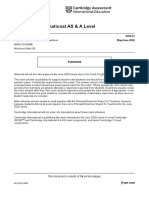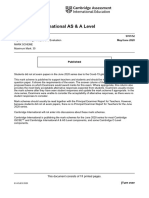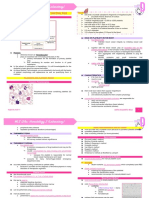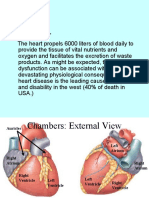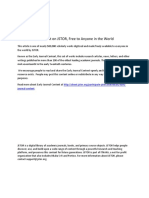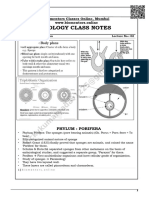Cambridge International AS & A Level: Biology 9700/22 May/June 2020
Cambridge International AS & A Level: Biology 9700/22 May/June 2020
Uploaded by
justinCopyright:
Available Formats
Cambridge International AS & A Level: Biology 9700/22 May/June 2020
Cambridge International AS & A Level: Biology 9700/22 May/June 2020
Uploaded by
justinOriginal Title
Copyright
Available Formats
Share this document
Did you find this document useful?
Is this content inappropriate?
Copyright:
Available Formats
Cambridge International AS & A Level: Biology 9700/22 May/June 2020
Cambridge International AS & A Level: Biology 9700/22 May/June 2020
Uploaded by
justinCopyright:
Available Formats
Cambridge International AS & A Level
BIOLOGY 9700/22
Paper 2 AS Level Structured Questions May/June 2020
MARK SCHEME
Maximum Mark: 60
Published
Students did not sit exam papers in the June 2020 series due to the Covid-19 global pandemic.
This mark scheme is published to support teachers and students and should be read together with the
question paper. It shows the requirements of the exam. The answer column of the mark scheme shows the
proposed basis on which Examiners would award marks for this exam. Where appropriate, this column also
provides the most likely acceptable alternative responses expected from students. Examiners usually review
the mark scheme after they have seen student responses and update the mark scheme if appropriate. In the
June series, Examiners were unable to consider the acceptability of alternative responses, as there were no
student responses to consider.
Mark schemes should usually be read together with the Principal Examiner Report for Teachers. However,
because students did not sit exam papers, there is no Principal Examiner Report for Teachers for the June
2020 series.
Cambridge International will not enter into discussions about these mark schemes.
Cambridge International is publishing the mark schemes for the June 2020 series for most Cambridge
IGCSE™ and Cambridge International A & AS Level components, and some Cambridge O Level
components.
This document consists of 13 printed pages.
© UCLES 2020 [Turn over
9700/22 Cambridge International AS & A Level – Mark Scheme May/June 2020
PUBLISHED
Generic Marking Principles
These general marking principles must be applied by all examiners when marking candidate answers. They should be applied alongside the
specific content of the mark scheme or generic level descriptors for a question. Each question paper and mark scheme will also comply with these
marking principles.
GENERIC MARKING PRINCIPLE 1:
Marks must be awarded in line with:
• the specific content of the mark scheme or the generic level descriptors for the question
• the specific skills defined in the mark scheme or in the generic level descriptors for the question
• the standard of response required by a candidate as exemplified by the standardisation scripts.
GENERIC MARKING PRINCIPLE 2:
Marks awarded are always whole marks (not half marks, or other fractions).
GENERIC MARKING PRINCIPLE 3:
Marks must be awarded positively:
• marks are awarded for correct/valid answers, as defined in the mark scheme. However, credit is given for valid answers which go beyond the
scope of the syllabus and mark scheme, referring to your Team Leader as appropriate
• marks are awarded when candidates clearly demonstrate what they know and can do
• marks are not deducted for errors
• marks are not deducted for omissions
• answers should only be judged on the quality of spelling, punctuation and grammar when these features are specifically assessed by the
question as indicated by the mark scheme. The meaning, however, should be unambiguous.
GENERIC MARKING PRINCIPLE 4:
Rules must be applied consistently e.g. in situations where candidates have not followed instructions or in the application of generic level
descriptors.
© UCLES 2020 Page 2 of 13
9700/22 Cambridge International AS & A Level – Mark Scheme May/June 2020
PUBLISHED
GENERIC MARKING PRINCIPLE 5:
Marks should be awarded using the full range of marks defined in the mark scheme for the question (however; the use of the full mark range may
be limited according to the quality of the candidate responses seen).
GENERIC MARKING PRINCIPLE 6:
Marks awarded are based solely on the requirements as defined in the mark scheme. Marks should not be awarded with grade thresholds or
grade descriptors in mind.
© UCLES 2020 Page 3 of 13
9700/22 Cambridge International AS & A Level – Mark Scheme May/June 2020
PUBLISHED
Science-Specific Marking Principles
1 Examiners should consider the context and scientific use of any keywords when awarding marks. Although keywords may be present, marks
should not be awarded if the keywords are used incorrectly.
2 The examiner should not choose between contradictory statements given in the same question part, and credit should not be awarded for
any correct statement that is contradicted within the same question part. Wrong science that is irrelevant to the question should be ignored.
3 Although spellings do not have to be correct, spellings of syllabus terms must allow for clear and unambiguous separation from other
syllabus terms with which they may be confused (e.g. ethane / ethene, glucagon / glycogen, refraction / reflection).
4 The error carried forward (ecf) principle should be applied, where appropriate. If an incorrect answer is subsequently used in a scientifically
correct way, the candidate should be awarded these subsequent marking points. Further guidance will be included in the mark scheme
where necessary and any exceptions to this general principle will be noted.
5 ‘List rule’ guidance
For questions that require n responses (e.g. State two reasons …):
• The response should be read as continuous prose, even when numbered answer spaces are provided
• Any response marked ignore in the mark scheme should not count towards n
• Incorrect responses should not be awarded credit but will still count towards n
• Read the entire response to check for any responses that contradict those that would otherwise be credited. Credit should not be
awarded for any responses that are contradicted within the rest of the response. Where two responses contradict one another, this
should be treated as a single incorrect response
• Non-contradictory responses after the first n responses may be ignored even if they include incorrect science.
© UCLES 2020 Page 4 of 13
9700/22 Cambridge International AS & A Level – Mark Scheme May/June 2020
PUBLISHED
6 Calculation specific guidance
Correct answers to calculations should be given full credit even if there is no working or incorrect working, unless the question states ‘show
your working’.
For questions in which the number of significant figures required is not stated, credit should be awarded for correct answers when rounded
by the examiner to the number of significant figures given in the mark scheme. This may not apply to measured values.
For answers given in standard form, (e.g. a × 10n) in which the convention of restricting the value of the coefficient (a) to a value between 1
and 10 is not followed, credit may still be awarded if the answer can be converted to the answer given in the mark scheme.
Unless a separate mark is given for a unit, a missing or incorrect unit will normally mean that the final calculation mark is not awarded.
Exceptions to this general principle will be noted in the mark scheme.
7 Guidance for chemical equations
Multiples / fractions of coefficients used in chemical equations are acceptable unless stated otherwise in the mark scheme.
State symbols given in an equation should be ignored unless asked for in the question or stated otherwise in the mark scheme.
Mark scheme abbreviations:
; separates marking points
/ alternative answers for the same marking point
R reject
A accept
I ignore
AVP any valid point
AW alternative wording (where responses vary more than usual)
ecf error carried forward
underline actual word underlined must be used by candidate (grammatical variants accepted)
max indicates the maximum number of marks that can be given
ora or reverse argument
© UCLES 2020 Page 5 of 13
9700/22 Cambridge International AS & A Level – Mark Scheme May/June 2020
PUBLISHED
Question Answer Marks
1(a) any two from 2
protein coat / capsid ; A capsomeres
nucleic acid core / DNA or RNA ;
acellular / AW ;
1(b) any three from 3
no, because
resolution of light microscope, too low / not high enough ;
only able to distinguish points 200nm or more apart
or
size of virus / 30 nm, too small for resolution of (light microscope) of 200 nm ; A range 100-300 nm
wavelength of light too long ;
idea that virus too small to interfere with light waves ;
1(c) any three from 3
virus binds to receptors (on host cell surface membrane) ;
ref. to specificity / complementary shapes / complementary binding ;
endocytosis ;
description ; e.g. membrane infolds / pinches in
vesicle formed ; A vacuole
Question Answer Marks
2(a) sinoatrial node / SAN, sends out, wave of excitation / impulses / electrical impulses ; R nerve impulses 2
wave of excitation / AW, spreads across atrial wall ;
2(b) any two from 2
non-conducting fibres between atrial and ventricle walls ;
impulse must pass down septum ;
AVN (in interatrial septum) delays impulse ;
(gives) time for atria to, complete contraction / empty ;
© UCLES 2020 Page 6 of 13
9700/22 Cambridge International AS & A Level – Mark Scheme May/June 2020
PUBLISHED
Question Answer Marks
2(c)(i) one mark if F and G are semilunar and E and H are bicuspid ; 3
one mark for E and G opens ;
one mark for F and H closes ;
E bicuspid / (left) atrioventricular, valve, closes
F semilunar / aortic, valve opens
G semilunar / aortic, valve closes
H bicuspid / (left) atrioventricular, valve opens
2(c)(ii) (during contraction) left ventricle, generates / AW, higher pressure (than left atrium) ; 2
A do not produce the same pressure when contracting
any one from
(because) wall of left ventricle thicker / more (cardiac) muscle, so reaches higher ;
data from Fig. 2.1 to show difference in pressure ;
Question Answer Marks
3(a) Mycobacterium tuberculosis ; A Mycobacterium bovis 1
3(b) any one from 1
live in an area that has cases of TB ;
recently returned from countries with TB ;
born in a country with TB ;
parents / grandparents whose origin country has TB ;
contact with a person who has TB ;
AVP ; e.g. ref. to compromised immune system
mother who is HIV-positive
© UCLES 2020 Page 7 of 13
9700/22 Cambridge International AS & A Level – Mark Scheme May/June 2020
PUBLISHED
Question Answer Marks
3(c) any three from 3
decrease in incidence over time for all groups
or
decrease in incidence over time for low, lower middle, upper middle and plateau for high income group ;
one example of, large / AW, differences in incidence ;
e.g. between, upper middle income and, low / lower middle
between high income and, low / lower middle / low and lower middle ;
between upper middle and high ;
decrease in incidence with income group increase (for each year), generally / overall / except for 2015 / 2016 low to lower
middle ;
low and lower middle similar incidence ;
data / manipulated data, to support any of above points ;
3(d) any two from 2
max 1 if no ref. to antigens
leprosy bacterium has similar (shaped) antigens ;
memory cells, recognise / bind, antigens on leprosy bacterium ;
anti-TB antibodies also bind to leprosy antigens ;
AVP ; e.g. similar / same, genes so synthesise similar proteins
© UCLES 2020 Page 8 of 13
9700/22 Cambridge International AS & A Level – Mark Scheme May/June 2020
PUBLISHED
Question Answer Marks
3(e) any three from 3
artificial active natural passive
deliberate / AW or not deliberate / from mother / in breast milk / across placenta ;
A from medical staff
vaccine / (foreign) antigens in injection or antibodies passed on ;
immune response or no immune response ;
antibodies / memory cells produced or no, antibodies / memory cells produced ;
longer lasting or short-lived ;
protection not immediate or immediate protection ;
Question Answer Marks
4(a) much / AW, rough endoplasmic reticulum / rough ER / RER for, polypeptide / protein / collagen, synthesis ; A for translation 2
many mitochondria provide, energy / ATP, for, polypeptide / protein / collagen, synthesis ;
large nucleus indicates, active cell / (much) transcription ;
4(b)(i) any two from 2
in trachea ;
in, bronchus / bronchi ;
if only one correct structure named, allow one qualification mark
trachea
C-shaped / incomplete, rings ;
surround smooth muscle ;
bronchus
plates / irregular ;
© UCLES 2020 Page 9 of 13
9700/22 Cambridge International AS & A Level – Mark Scheme May/June 2020
PUBLISHED
Question Answer Marks
4(b)(ii) any two from 2
keep airways open ;
provides support ;
allow flexibility ; allow described e.g. bending neck, swallowing food
rings allow, lengthening / widening, during, breathing in / inspiration / inhalation ;
4(c)(i) peptide (bond) ; 1
4(c)(ii) any three from 3
collagen, structural / fibrous, protein
or
collagen gives strength / flexibility ;
glycine / gly, small / smallest, amino acid ; A has H as, R-group / side chain
glycine / gly, regular / every third amino acid ;
(so) triple helix tightly packed / three polypeptides closely associated / AW ;
ref. to (peptide bond ) NH of gly can form hydrogen bond with (peptide bond) C=O of adjacent amino acid (in other
polypeptide) ;
Question Answer Marks
5(a) presence of sucrose (in sieve tube) lowers water potential (of phloem sap) ; A makes water potential more negative 4
water enters (sieve tube), by osmosis / down water potential gradient ;
increases volume (in sieve tube) ;
increases hydrostatic pressure (in sieve tube at source) ; A turgor pressure
ref. to lower hydrostatic pressure (in sieve tube at sink) ;
allow ecf for no ref. to, hydrostatic / turgor
detail ; e.g. sucrose removed at sink
water follows sucrose that exits sink
movement of, (phloem) sap / sucrose, down pressure gradient / from high to low hydrostatic pressure ;
mass flow ;
5(b)(i) glycosidic ; 1
© UCLES 2020 Page 10 of 13
9700/22 Cambridge International AS & A Level – Mark Scheme May/June 2020
PUBLISHED
Question Answer Marks
5(b)(ii) nucleotide components are base, pentose sugar, phosphate ; 2
UDP has, uracil and ribose and two phosphates / one extra phosphate ;
5(b)(iii) max three if describing breakdown of sucrose 4
allow points from diagrams
any four from
induced fit shape of, substrates / UDP and glucose, not (fully) complementary to shape of active site (of sucrose synthase) ;
lock and key shape of, substrates / UDP and glucose, complementary to shape of active site (of sucrose synthase) ; allow
ecf if no ref. to shape
induced fit active site flexible / moulds around, substrates / UDP and glucose ; AW
lock and key active site does not change shape / is not flexible / AW ;
induced fit (active site moulds around so) idea of provides better fit / fully complementary ;
lock and key substrate fits into active site ;
5(c) α-glucose ; A glucose R β-glucose 4
α, 1-4 ;
α, 1-6 ; bond types either way round
glycogen ;
© UCLES 2020 Page 11 of 13
9700/22 Cambridge International AS & A Level – Mark Scheme May/June 2020
PUBLISHED
Question Answer Marks
6(a) 3
Stage of cell cycle
(G1 phase)
S phase interphase ;
G2 phase ;
prophase
metaphase
(mitosis)
anaphase ;
(telophase)
(cytokinesis)
one mark for interphase
one mark for S phase and G2 phase in correct sequence
one mark for prophase, metaphase and anaphase in correct sequence
6(b) Vincristine: x x ; 2
5-fluorouracil : x x x x ;
© UCLES 2020 Page 12 of 13
9700/22 Cambridge International AS & A Level – Mark Scheme May/June 2020
PUBLISHED
Question Answer Marks
6(c) any three from 3
blood smear differences
large / larger, numbers of lymphocytes ;
more lymphocytes than normal blood smear ;
as blood smear or lymphocyte difference
immature / not fully developed ;
ref. to no large nuclei / nuclei not pronounced small nuclei ; A nuclei not visible
lymphocyte difference
non-functional / AW ;
detail of lack of function for either B-lymphocytes or T-lymphocytes ;
AVP ; e.g. ref. to difficult to distinguish between lymphocytes and monocytes ; A no monocytes visible
© UCLES 2020 Page 13 of 13
You might also like
- (How It Works) DK - How The Brain Works - The Facts Visually Explained (2020) MEMORY, LEARNING, AND THINKINGDocument27 pages(How It Works) DK - How The Brain Works - The Facts Visually Explained (2020) MEMORY, LEARNING, AND THINKINGGabryella damayanti Butar-ButarNo ratings yet
- Zoology Lab ManualDocument135 pagesZoology Lab ManualColeen MackayNo ratings yet
- Julia Herschensohn - Language Development and Age-Cambridge University Press (2007)Document340 pagesJulia Herschensohn - Language Development and Age-Cambridge University Press (2007)Khoirun NisaNo ratings yet
- Cambridge International AS & A Level: Biology 9700/52 May/June 2020Document9 pagesCambridge International AS & A Level: Biology 9700/52 May/June 2020saliwe.muzavaziNo ratings yet
- Cambridge International AS & A Level: Biology 9700/33 May/June 2020Document9 pagesCambridge International AS & A Level: Biology 9700/33 May/June 2020Mohamed HNo ratings yet
- 9700 - s20 - Ms - 42 Biologya2Document20 pages9700 - s20 - Ms - 42 Biologya2Fatahna KhanzadaNo ratings yet
- Cambridge International AS & A Level: Biology 9700/42 May/June 2020Document20 pagesCambridge International AS & A Level: Biology 9700/42 May/June 2020justinNo ratings yet
- Cambridge International AS & A Level: Biology 9700/23 May/June 2020Document15 pagesCambridge International AS & A Level: Biology 9700/23 May/June 2020Mohamed HNo ratings yet
- Cambridge International AS & A Level: Biology 9700/31 May/June 2020Document8 pagesCambridge International AS & A Level: Biology 9700/31 May/June 2020Ali ImranNo ratings yet
- Cambridge International AS & A Level: Biology 9700/32 May/June 2020Document9 pagesCambridge International AS & A Level: Biology 9700/32 May/June 2020David AdigboNo ratings yet
- Cambridge International AS & A Level: Biology 9700/52 May/June 2020Document9 pagesCambridge International AS & A Level: Biology 9700/52 May/June 2020Aneeqa KhanNo ratings yet
- Cambridge International AS & A Level: Biology 9700/32 May/June 2020Document9 pagesCambridge International AS & A Level: Biology 9700/32 May/June 2020rohanuday3No ratings yet
- Cambridge International AS & A Level: Biology 9700/33 May/June 2020Document9 pagesCambridge International AS & A Level: Biology 9700/33 May/June 2020donald kazaNo ratings yet
- Cambridge International AS & A Level: Physics 9702/22 May/June 2020Document14 pagesCambridge International AS & A Level: Physics 9702/22 May/June 2020Kamran KhanNo ratings yet
- Cambridge International AS & A Level: Biology 9700/34 May/June 2020Document9 pagesCambridge International AS & A Level: Biology 9700/34 May/June 2020zoha.jamal6No ratings yet
- Cambridge International AS & A Level: Biology 9700/42 March 2020Document23 pagesCambridge International AS & A Level: Biology 9700/42 March 2020Y. PurwandariNo ratings yet
- Cambridge International AS & A Level: Physics 9702/23 May/June 2020Document14 pagesCambridge International AS & A Level: Physics 9702/23 May/June 2020junk filesNo ratings yet
- Cambridge International AS & A Level: Biology 9700/41 May/June 2020Document20 pagesCambridge International AS & A Level: Biology 9700/41 May/June 2020KomalNo ratings yet
- Cambridge International AS & A Level: Physics 9702/22 May/June 2020Document14 pagesCambridge International AS & A Level: Physics 9702/22 May/June 2020junk filesNo ratings yet
- Cambridge International AS & A Level: Chemistry 9701/52 May/June 2020Document11 pagesCambridge International AS & A Level: Chemistry 9701/52 May/June 2020icqq9qjw3No ratings yet
- Cambridge International AS & A Level: Physics 9702/34 May/June 2020Document9 pagesCambridge International AS & A Level: Physics 9702/34 May/June 2020Arthur WirjoNo ratings yet
- O Level 2020 Ppaer 2B MSDocument12 pagesO Level 2020 Ppaer 2B MSChiam Zi YiNo ratings yet
- Cambridge International AS & A Level: Physics 9702/41 May/June 2020Document19 pagesCambridge International AS & A Level: Physics 9702/41 May/June 2020Mahi ChowdhuryNo ratings yet
- Cambridge International AS & A Level: Physics 9702/42 May/June 2020Document17 pagesCambridge International AS & A Level: Physics 9702/42 May/June 2020Tino KambaniNo ratings yet
- Cambridge International AS & A Level: Biology 9700/43 May/June 2022Document23 pagesCambridge International AS & A Level: Biology 9700/43 May/June 2022Aneeqa KhanNo ratings yet
- 9693 s22 Ms 11 Test 2022 Answerkey PDFDocument14 pages9693 s22 Ms 11 Test 2022 Answerkey PDFBeatriz ColioNo ratings yet
- 5054 s20 Ms 22 PDFDocument13 pages5054 s20 Ms 22 PDFJack KowmanNo ratings yet
- Cambridge International AS & A Level: Physics 9702/52 May/June 2020Document11 pagesCambridge International AS & A Level: Physics 9702/52 May/June 2020Muhammad RidzwanNo ratings yet
- Cambridge International AS & A Level: Chemistry 9701/22 May/June 2020Document12 pagesCambridge International AS & A Level: Chemistry 9701/22 May/June 2020Zara ahmedNo ratings yet
- Cambridge International AS & A Level: Biology 9700/34 May/June 2022Document8 pagesCambridge International AS & A Level: Biology 9700/34 May/June 2022mariakhan.educationNo ratings yet
- Cambridge International AS & A Level: Chemistry 9701/52 May/June 2020Document11 pagesCambridge International AS & A Level: Chemistry 9701/52 May/June 2020Muhammad RidzwanNo ratings yet
- Cambridge International AS & A Level: Physics 9702/41 May/June 2020Document19 pagesCambridge International AS & A Level: Physics 9702/41 May/June 2020Tino KambaniNo ratings yet
- Biology Exam Paper DraftDocument11 pagesBiology Exam Paper Draftkaysoneducation09No ratings yet
- Cambridge IGCSE™ (9-1) : BIOLOGY (9-1) 0970/61 May/June 2020Document8 pagesCambridge IGCSE™ (9-1) : BIOLOGY (9-1) 0970/61 May/June 2020Anisa KhanamNo ratings yet
- Cambridge International AS & A Level: Biology 9700/21 May/June 2022Document13 pagesCambridge International AS & A Level: Biology 9700/21 May/June 2022alashigidi123No ratings yet
- Cambridge International AS & A Level: Biology 9700/23 October/November 2020Document20 pagesCambridge International AS & A Level: Biology 9700/23 October/November 2020Vinayak KhedekarNo ratings yet
- Cambridge International AS & A Level: Chemsitry 9701/33 May/June 2022Document10 pagesCambridge International AS & A Level: Chemsitry 9701/33 May/June 2022Masoud AliNo ratings yet
- Cambridge International AS & A Level: Chemistry 9701/41 May/June 2020Document15 pagesCambridge International AS & A Level: Chemistry 9701/41 May/June 2020中华雅思王No ratings yet
- Cambridge International AS & A Level: Biology 9700/21 October/November 2020Document13 pagesCambridge International AS & A Level: Biology 9700/21 October/November 2020Sinin VegaNo ratings yet
- Igcse Biology0610 Variant 2 May/june 2020Document12 pagesIgcse Biology0610 Variant 2 May/june 2020sally.mansterlyNo ratings yet
- Cambridge IGCSE™: Biology 0610/63 May/June 2020Document7 pagesCambridge IGCSE™: Biology 0610/63 May/June 2020bali yunNo ratings yet
- Cambridge IGCSE™ (9-1) : BIOLOGY (9-1) 0970/62 May/June 2020Document9 pagesCambridge IGCSE™ (9-1) : BIOLOGY (9-1) 0970/62 May/June 2020Anisa KhanamNo ratings yet
- Cambridge Pre-U: Biology 9790/03 October/November 2020Document20 pagesCambridge Pre-U: Biology 9790/03 October/November 2020rkblsistemNo ratings yet
- Cambridge International AS & A Level: Chemistry 9701/21 May/June 2020Document10 pagesCambridge International AS & A Level: Chemistry 9701/21 May/June 2020orisunayo olugbengaNo ratings yet
- Cambridge International AS & A Level: Biology 9700/32 May/June 2020Document9 pagesCambridge International AS & A Level: Biology 9700/32 May/June 2020dxD.T.C.dxNo ratings yet
- Cambridge International AS & A Level: Biology 9700/42Document25 pagesCambridge International AS & A Level: Biology 9700/42mansoormohayuddinNo ratings yet
- Cambridge IGCSE™: Physics 0625/43 October/November 2020Document16 pagesCambridge IGCSE™: Physics 0625/43 October/November 2020Nisha zehraNo ratings yet
- Cambridge International AS & A Level: Physics 9702/42 October/November 2020Document16 pagesCambridge International AS & A Level: Physics 9702/42 October/November 2020usmansafeer100No ratings yet
- Cambridge International AS & A Level: Biology 9700/42 February/March 2022Document22 pagesCambridge International AS & A Level: Biology 9700/42 February/March 2022NjoroNo ratings yet
- Cambridge IGCSE™: Physics 0625/42 October/November 2020Document19 pagesCambridge IGCSE™: Physics 0625/42 October/November 2020Nisha zehraNo ratings yet
- Cambridge International AS & A Level: Physics 9702/42 May/June 2022Document16 pagesCambridge International AS & A Level: Physics 9702/42 May/June 2022PommeNo ratings yet
- Cambridge IGCSE™: Biology 0610/61 May/June 2022Document9 pagesCambridge IGCSE™: Biology 0610/61 May/June 2022Bashir SsekalegaNo ratings yet
- Cambridge International AS & A Level: Chemistry 9701/42 May/June 2020Document14 pagesCambridge International AS & A Level: Chemistry 9701/42 May/June 2020yooga palanisamyNo ratings yet
- Cambridge IGCSE™: Physics 0625/41 October/November 2020Document17 pagesCambridge IGCSE™: Physics 0625/41 October/November 2020Nisha zehraNo ratings yet
- Cambridge IGCSE™: Physics 0625/31 October/November 2020Document14 pagesCambridge IGCSE™: Physics 0625/31 October/November 2020Nisha zehraNo ratings yet
- Cambridge IGCSE™: Physics 0625/52 March 2020Document11 pagesCambridge IGCSE™: Physics 0625/52 March 2020KNEWTON EducationNo ratings yet
- Cambridge IGCSE™: Biology 0610/53 May/June 2020Document7 pagesCambridge IGCSE™: Biology 0610/53 May/June 2020Saleha ShafiqueNo ratings yet
- Cambridge International AS & A Level: Biology 9700/42 May/June 2022Document22 pagesCambridge International AS & A Level: Biology 9700/42 May/June 2022thoriqNo ratings yet
- Cambridge IGCSE™ (9-1) : BIOLOGY (9-1) 0970/51 May/June 2020Document8 pagesCambridge IGCSE™ (9-1) : BIOLOGY (9-1) 0970/51 May/June 2020Anisa KhanamNo ratings yet
- Cambridge IGCSE™ (9-1) : BIOLOGY (9-1) 0970/51 May/June 2020Document8 pagesCambridge IGCSE™ (9-1) : BIOLOGY (9-1) 0970/51 May/June 2020Anisa KhanamNo ratings yet
- Cambridge International AS & A Level: Physics 9702/41 May/June 2022Document16 pagesCambridge International AS & A Level: Physics 9702/41 May/June 2022Anar NyambayarNo ratings yet
- Cambridge International AS & A Level: Physics 9702/42 May/June 2021Document19 pagesCambridge International AS & A Level: Physics 9702/42 May/June 2021Mahebul MazidNo ratings yet
- VMWARE Certified Spring Professional Certification Cased Based Practice Questions - Latest EditionFrom EverandVMWARE Certified Spring Professional Certification Cased Based Practice Questions - Latest EditionNo ratings yet
- 1.05 AnemiaDocument55 pages1.05 AnemiaKrishNo ratings yet
- DOTTDocument31 pagesDOTTMAHESH KOUJALAGINo ratings yet
- Body Fluids and Circulation SNS 02 (Chapter Wise Test) - 962 - 1723075667475Document13 pagesBody Fluids and Circulation SNS 02 (Chapter Wise Test) - 962 - 1723075667475surajsinghpahi2024No ratings yet
- Nutrition in Animals QuestionsDocument13 pagesNutrition in Animals QuestionsHussein Adan IbrahimNo ratings yet
- The Muscular System of The Frog Group 6 1Document49 pagesThe Muscular System of The Frog Group 6 1Al Johan AtienzaNo ratings yet
- MLS 12aa: Hematology 2 (Laboratory) : Module 1: Platelet Count and Platelet Function TestsDocument30 pagesMLS 12aa: Hematology 2 (Laboratory) : Module 1: Platelet Count and Platelet Function TestsRuphele Anne QuitagNo ratings yet
- SynapsesDocument11 pagesSynapsesApple AcaNo ratings yet
- Living With Your Biome How The Bacterial Microbiome Impacts Ocular Surface Health and DiseaseDocument16 pagesLiving With Your Biome How The Bacterial Microbiome Impacts Ocular Surface Health and DiseaseSadab KhanNo ratings yet
- 24 Sex, Sexuality, and The BrainDocument36 pages24 Sex, Sexuality, and The BrainquackNo ratings yet
- Body Fluids & ElectrolytesDocument26 pagesBody Fluids & ElectrolytesMohamad Zekry Zuhairy100% (1)
- The Uses of Water in Health and DiseaseDocument156 pagesThe Uses of Water in Health and DiseaseSaurabh AgarwalNo ratings yet
- Practice Test 2 Upper LimbDocument4 pagesPractice Test 2 Upper LimbhavokkNo ratings yet
- Mechanism of Inflammatory Associated Impairment of Sperm Function, Spermatogenesis and SteroidogenesisDocument10 pagesMechanism of Inflammatory Associated Impairment of Sperm Function, Spermatogenesis and SteroidogenesismadinandNo ratings yet
- Get The Science of Psychology: An Appreciative View 5th Edition Laura A. King - Ebook PDF Free All ChaptersDocument41 pagesGet The Science of Psychology: An Appreciative View 5th Edition Laura A. King - Ebook PDF Free All Chapterswaellzietek100% (6)
- Head (Skull, Scalp, Hair) : Head-To-Toe Assessment (C. Eyebrows, Eyes and Eyelashes)Document15 pagesHead (Skull, Scalp, Hair) : Head-To-Toe Assessment (C. Eyebrows, Eyes and Eyelashes)anne002No ratings yet
- Assignment GU PMB201 Instructions - Fall 23Document10 pagesAssignment GU PMB201 Instructions - Fall 23yoyomotazNo ratings yet
- Pathology of HEART - 1Document175 pagesPathology of HEART - 1Abdukadir AzamNo ratings yet
- Cardiac Cycle: DR - Lalitha Shanmugam, Professor of Physiology, VMCHDocument56 pagesCardiac Cycle: DR - Lalitha Shanmugam, Professor of Physiology, VMCHRamakrishnanNo ratings yet
- BIOLOGE EXAM محلولDocument4 pagesBIOLOGE EXAM محلولmohammedNo ratings yet
- Circulatory SystemDocument9 pagesCirculatory SystemKyla Mae JinonNo ratings yet
- Lie Detection TechniquesDocument149 pagesLie Detection TechniquesArvie lauretaNo ratings yet
- GENBIO1 - Q1 - MOD5 OF 8 Cell Modifications What Fits In.Document21 pagesGENBIO1 - Q1 - MOD5 OF 8 Cell Modifications What Fits In.altheacasi2007No ratings yet
- Biology 8461/2H: Mark SchemeDocument21 pagesBiology 8461/2H: Mark SchemeMohamad HabbalNo ratings yet
- Early Journal Content On JSTOR, Free To Anyone in The WorldDocument3 pagesEarly Journal Content On JSTOR, Free To Anyone in The WorldVakamalla SubbareddyNo ratings yet
- Health Psychology 10th Edition Taylor Test Bank 1Document36 pagesHealth Psychology 10th Edition Taylor Test Bank 1josephphillipskxscpqtazi100% (41)
- Animal Kingdom Lecture - 2 NotesDocument10 pagesAnimal Kingdom Lecture - 2 Notesrajvicky121500No ratings yet
- Feedback Mechanism Sitti Selina B. SamanDocument15 pagesFeedback Mechanism Sitti Selina B. SamanBarangay PamucutanNo ratings yet
















